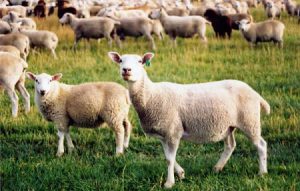What is Eco-wool?
 Eco Wool is used in some of the mattresses and wool bedding products that we carry. This wool is shorn from sheep grown by select ranches in the Pacific Northwest, where the fog, rain and cooler weather create wonderful grazing conditions, and processed by Woolgather Carding Mill in Montague, CA. Although Eco Wool is not certified organic, the growers are restricted from using chemical pesticides, herbicides, antibiotics, and hormones; and they adhere to defined sustainability and cruelty free standards. In addition, the wool is certified organically processed and independently tested for herbicides, pesticides, and naturally occurring heavy metals such as lead and arsenic. This wool is the purest you can find, comparable to certified organic but at a lower price.
Eco Wool is used in some of the mattresses and wool bedding products that we carry. This wool is shorn from sheep grown by select ranches in the Pacific Northwest, where the fog, rain and cooler weather create wonderful grazing conditions, and processed by Woolgather Carding Mill in Montague, CA. Although Eco Wool is not certified organic, the growers are restricted from using chemical pesticides, herbicides, antibiotics, and hormones; and they adhere to defined sustainability and cruelty free standards. In addition, the wool is certified organically processed and independently tested for herbicides, pesticides, and naturally occurring heavy metals such as lead and arsenic. This wool is the purest you can find, comparable to certified organic but at a lower price.
Sustainability and Cruelty-free Standards
Proper Grazing Methods: Woolgather's growers rotate sheep regularly to different pastures to allow vegetation to recover from grazing. Overstocking and infrequent rotation produces soil erosion, more invasive plants, and the need to bring in outside feed. Proper grazing techniques reduce soil erosion, create higher quality wool, and reduce the risk of sheep acquiring internal parasites.
Predator Friendly: The ranches are encouraged to use trained guardian dogs and larger animals, such as llamas, to protect their flock from predators, rather than trapping, poisoning, or shooting. Predators play an important role in maintaining healthy ecosystems; therefore they simply scare them away from the sheep.
Healthy Veterinary Practices: Only certain kinds of medications and supplements can be used to treat the sheep. They encourage alternative caring methods to keep sheep healthy with the use of fewer chemicals. Generally, sheep raised in open pastures are of better health and require less veterinary care.
Chemical Control: Woolgather opposes the use of herbicides and pesticides on fields where the sheep will be grazing. They are able to determine if wool has been in contact with harmful chemicals during routine testing.
Specifications for breed, color, strength and micron-width: Their wool blend uses fiber from six to eight different breeds of sheep. A mix of coarse and finer wool with varying crimps are used to create strong, durable wool batting that retains its loft and resiliency longer.
Common Wool Industry Practices that Woolgather Opposes
Carbonizing: Dipping wool in strong acids to dissolve residual vegetable matter.
Chemical Crimping: After carbonizing, wool fibers are unnaturally straightened and require a chemical “perm” like treatment in order to regain their natural crimp, coiled structure. Woolgather's wool has a natural crimp that lasts longer and provides superior resilience.
Dipping: At many farms, sheep are subject to a bath in a pesticide solution. Woolgather requires a more holistic approach.
Bleaching: In order to get the purest white and bright colored wool fibers, most wool is bleached and dyed. Their wool remains a natural white color, completely free of bleaches and dyes.
Harmful Shearing: Often when sheep are sheared the process is rushed, which can result in broken limbs and deep cuts into the skin. Woolgather's growers work with highly trained shearers who are able to shear quickly and gently so that there is no harm to the sheep.
Mulesing: Cutting patches of skin of the sheep to discourage infection and inhibit flies from laying eggs in the folds is used primarily with Australian Merino sheep. None of Woolgather's growers use this cruel practice.
Overgrazing: In addition to harming the land, overgrazing decreases overall wool quality. More invasive plants begin to grow which can increase the amount of vegetable matter in the wool, often making carbonization necessary.
